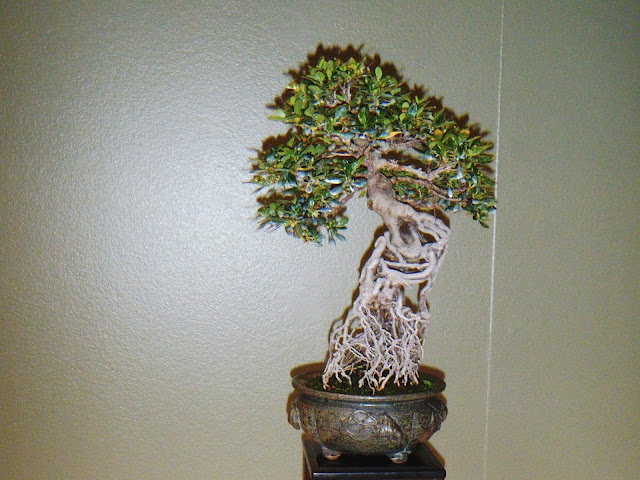(Readers who receive the Fort Wayne Bonsai Club newsletter will see this in the current issue in slightly different form.)
During
the Exhibit Critique at the 2016 Mid-America show, Colin Lewis described a
grafting technique that gets around one of the common difficulties encountered
in grafting. That
difficulty is making sure that the cambium of the scion and the cambium of the stock
line up with each other at all (or almost all) points. Until your eye has been
trained by some experience, making sure that the cambium layers line up all
around can be a very frustrating
affair.
The
technique Lewis shared abandons any attempt to make the cambium line up all
around in exchange for eight guaranteed points of cambium-to-cambium contact. Let
me try to explain the method, using some twigs cut from the ash tree
in our front yard for the purpose. (In case anyone wonders, the intent of this post is to explain and illustrate the concept, not record an actual graft.)
Step 1. The first step is to trim the scion flat on one
side. The cut needs to be as smooth as possible. Then turn the scion over and
trim the opposite side in the same way. The surfaces of the trimmed areas need
to be as close to parallel as possible.
| The green arrows point to the cambium, the thin green layer between the brown of the bark and the off-white of the sapwood. The chartreuse arrow points to the foliage end of the scion. |
This technique, by the way, can be used equally well when a seedling or rooted cutting is being grafted in and its own roots are being retained until the graft takes. You just trim down into the sapwood on opposite sides, as illustrated, at the point on the scion where you want it to contact the stock. Make the trimmed-down area just slightly wider than the flap bed (the exposed area of cambium and sapwood on the stock; see picture 2.)
Step 2. Cut the flap in the stock.
| Again, the green arrows point to the cambium, the chartreuse toward the foliage. |
Step 3. If the scion is thin enough after trimming, you
can skip step 3. But if the scion is thick enough that you won’t be able to
close the flap properly, you need a notch, no wider than the scion and just
deep enough that the upper surface of the scion lies flush, or nearly flush,
with the top of the notch. Note the red arrow! If I had actually
been making a graft, rather than simply trying to illustrate a technique, I
would not have left the floor of the notch so rough. For an actual
graft, it needs to be smooth and flat.
| Do not leave the floor of the notch rough like this. |
By the
way, you can make the notch at any angle you choose, depending on the angle of
growth you want the new branch to take. Handy, huh?
Step 4. When you
lay the scion in the notch, the line of cambium on each side is going to
cross each of the lines of cambium in the stock. That gives you four firm
points of cambium-to-cambium contact, two on each side of the scion on its underside.
| Each of the green circles sits above a point of cambium-to-cambium contact on the underside of the scion. |
Step 5. The
underside of the flap also has two longitudinal lines of cambium, and when you
close the flap, each of them is going to come into contact with each of the two
cambium lines on the upper side of the scion. This gives you four more points of
cambium-to-cambium contact.
You now have four cambium-to-cambium points of contact on the
underside of the scion, and four on the upper side, for a total of eight. This
is enough for a good join.
| Again, each green circle sits above a cambium-to-cambium contact point on the upper side of the scion, as well as one on the underside. |
It's important that the flap lie flat or nearly so, so that cambium-to-cambium contact can be re-established between the flap and its bed. Otherwise, you risk some dieback and an unsightly wound.
(Don't forget that when you make an actual graft, there are other things to consider as well: a very sharp knife and good aftercare, to name just two.)
Lewis
pointed out another benefit of this technique: Sometimes the stock branch is
intended to be cut off after the graft takes, and the scion is intended to take
over. In that event, you’ve introduced some movement into the eventual finished
branch in the process of making your graft!
:-) :-) :-)



